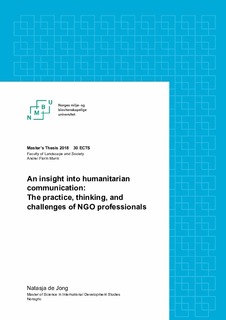| dc.description.abstract | Different factors, such as globalization and new information- and communication technologies, have changed the field of humanitarianism tremendously throughout the last decades (Barnett, 2005; Vestergaard, 2008). NGOs have become the leading actors in representing the global poor, sharing information about global poverty, promoting universal human rights, and raising awareness for humanitarian assistance (Cottle and Nolan, 2007; Peet and Hartwick, 2009). To provide this, NGOs are dependent on financial and moral support from governments, international organizations, and private donors. This research is focused on the last group, private donors, and looks at how NGOs reach out to the Western public, inform them about poverty and development, and ask their (financial) support. Humanitarian communication is widely critiqued throughout the years, where the portrayal of poverty and development is argued to be unbalanced. There is a lack of understanding humanitarian communication from the NGOs point of view. The goal of this study has been to uncover the broader landscape of humanitarian communication by looking into the thinking, practice, and challenges of NGO professionals engaged in humanitarian communication. Drawing on in-depth semi-structured interviews with NGO professionals in Western NGOs and a content analysis of narratives, this research explores the practice of humanitarian communication. The findings show that there are different types of communication, aimed at creating a strong brand, raising awareness, and raising private donations. These different communication types are all pointed towards the ultimate purpose which is to prevent or promote a specific cause, or more generally to help people in need. In order to reach this purpose, the findings of this research show that NGOs are challenged in using their communication platforms as holistic and consistent as possible, while at the same time convincing the public to support them. This is accompanied by strategies that contribute to an unbalanced portrayal of poverty and development, but are hard to avoid. The findings of this research show that there are certain aspects NGOs can take into account in order to give a more balanced portrayal of poverty and development and still raise private donations. | nb_NO |

